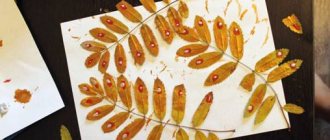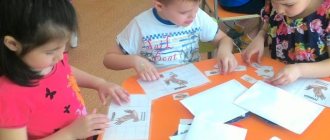Planning a flower bed
Depending on how much area you can allocate to a novice gardener and where this piece of land is located, we plan the number of plants to sow and choose the shape of the flowerbed.
Give your preschooler complete freedom in choosing plants and planning a flower garden - I wonder what will happen in the end! Small children will have to be guided gently and quietly. If conditions permit, the direction of the flowerbed is chosen from north to south: seeds of tall plants are sown in the north, plants of shorter height are sown to the south. Tell the young designer that the flowerbed can be made in different configurations: round, oval, rectangular, triangular (repeat geometric shapes at the same time!) and arbitrary (for example, in the shape of a butterfly or a car). It is advisable to place a round and triangular flower bed on a small hill. So that all the flowers are evenly illuminated.
The flower garden will look more attractive if you fence it with a fence. In stores, next to expensive fences, they always sell nice, inexpensive plastic fences. The edges of the flower bed can be lined with stone, brick, ceramics, or a low fence can be made. And decoratively, and without additional costs.
Be sure to explain to your child that tall plants are planted in the background of the flower garden. In the center there are lower flowers, and from the very edge of the flower bed it is customary to plant very low flowers. With such a “tier” there will be enough light for all plants. In a round and triangular flower bed, as a rule, tall flowers are planted in the center and low flowering plants are planted around in segments or in a circle. There is nothing stopping you from buying a few dahlia tubers now and inviting your child to make this powerful and very beautiful plant the “soloist” of his flower garden. Gladioli are also suitable for the “main role”. If you are lucky, and by the Day of Knowledge the flowers in the children's flowerbed will be in excellent shape, you can collect a chic bouquet. And bring your own flowers to school on September 1st.
There is also a simpler option - to entrust the child’s care with plants in flower beds or containers. Marigolds, calendula, tricolor bindweed, nasturtium, low-growing asters, dahlias, etc. are suitable for this. But remember that moisture quickly evaporates from a small volume of soil in a container in hot weather, and the soil is also greatly depleted. Therefore, it is necessary to water and feed the plants in flower beds in a timely manner. But weeding in such a “mini-garden” is kept to a minimum.
Planting vegetables
First, choose a place that will be comfortable for both you and the child - it can be a table or the floor. Then we cover the surface with oilcloth or paper to protect it from spilled soil and lay out everything that will be useful for planting. We invite the child, offer him to fill the pots with soil, plant the seeds, and, if necessary, add soil on top. After this, we water the plantings, put the pots in the prepared place and clean up after ourselves.
This is how our landing took place.
Pour soil into pots. Having placed all the materials on the floor, I called to my son, “Let’s go plant some seeds.” Daniel immediately took a shovel and began to pour the earth, I just asked him to sit on the mat so that the earth would not spill onto the floor.
If the child does not know how to pour, then it is better to first slowly show him and talk through each action: “I take the pot, I take the shovel. I scoop up soil with a spatula and pour it into a pot. Now try it." In order for the child to better understand what you want to explain, you must first show it and then pronounce it. Or vice versa, but the main thing is not at the same time.
Daniel poured soil into eight pots and was a little tired, so he asked me to fill the remaining pots.
To support my son, I noted his efforts: “You filled so many pots with earth! Let's count!" Lately, Daniel likes to count everything, but so far he can only count up to four or five, and then we work together - my son repeats after me.
Pour seeds into pots. I prepared a box lid for the seeds, but getting out small seeds turned out to be inconvenient. So I poured them into my hand, and Daniel took them from there. Working with seeds is great practice for motor skills and pincer grip.
When the seeds were planted, I told them that it was important to give the roots space so that they could grow larger, and Daniel laid out the grains on different sides of the pot
Sprinkle the seeds with soil and water. Daniel loves to water, or rather, flood plants with water. Therefore, I suggested a watering can with a thin spout and a spray bottle - this way there was less chance of filling the pots to the brim. In addition, with two options for tools, the child has the opportunity to make a choice.
We divided the work - I cover the seeds with soil, and my son waters
After watering, we repeated once again what we had planted, and Daniel proudly showed his dad what we had done.
After any lesson we have cleaning. I removed the bag of soil, and Daniel brought a dustpan and a broom. So far, the son is not doing everything, but his participation in the process and understanding of the algorithm of actions is already bearing fruit. I observe this myself, and I know from the stories of my grandmother and husband: after finishing some activity, Daniel puts everything back in its place without reminders. Therefore, I am sure that there is no need to insist, it is enough to show your involvement, and then the son will gladly join in the cleaning.
It happens that in response to my proposal, “Let’s put it back,” Daniel may say, “I don’t want to!” Then I say: “Okay. But I want it to be clean, I want to clean.” This often works, and the son says: “And I want it!” Then I ask: “Great! Please bring a broom." It happens that the son may walk around first, and then bring a broom or start cleaning too. I thank: “Thank you! Now it’s so clean, it’s nice.”
There is a point that I missed - I needed to make separate pictures of what we planted, but I had to tear off the pictures of vegetables from the bag of seeds.
We placed our plantings on a garden chair and placed everything we needed for watering next to it.
Why do you need a vegetable garden in kindergarten?
A vegetable garden in a kindergarten is needed to introduce preschoolers to nature and its seasonal changes.
In addition, a vegetable garden in a kindergarten and the feasible work of children on its territory influence the formation of elementary environmental concepts in preschoolers.
A vegetable garden in a kindergarten is also an opportunity to see the results of your work. Joint work in the garden provides an opportunity to learn responsibility, contributes to the formation of work skills and the unification of the children's team. And, of course, a vegetable garden in a kindergarten and work in the fresh air help preserve and strengthen the children’s health.
Vegetable garden in kindergarten: rules of organization
In order to create a vegetable garden in a kindergarten, it is necessary to determine a place on the territory of the kindergarten that would be located in a lighted space. A vegetable garden in a kindergarten has its own design features.
The size of the garden in a kindergarten is influenced by the local conditions of the kindergarten's location. But, it is desirable that each child has at least 0.5 m² of garden space.
To make it more convenient for children to reach the middle of the bed with their hands, the width of the bed should not be more than sixty centimeters. The length of one bed is approximately three meters.
To prevent water from draining from the garden bed when watering, you can make a wooden frame. A distance of fifty centimeters is left between the beds so that children can freely pass between them without damaging the plantings.
A garden in a kindergarten must also have a main path at least one meter wide, thanks to which children can walk to the beds, and the teacher can conduct organized educational activities and observations.
A table and bench are required. There, children will be able to relax after completing work assignments, observe plants and engage in joint activities with the teacher.
Growing plants with children
There is a very exciting activity with children - growing plants together. Our offer is almost impossible to refuse, because it will help you with your children...
1) have a great time; 2) learn a lot of new things from the field of botany; 3) develop observation, ability to analyze and plan; 4) develop patience and the ability to “be responsible for those you have tamed.”
So here we go.
- Sow balsam seeds
- Propagate from leaf cuttings
- Sprout begonia from tubers
- Root Cyperus
- Plant a hippeastrum bulb
- Plant mushrooms
- Grow microgreens together for the table
- Sprout cones and nuts
Sow balsam seeds >>>
Once upon a time it embodied the idea of bourgeois comfort... Modern varieties of balsam are very diverse. You can grow plants of different colors, including those with double flowers. Balsam seeds germinate easily, requiring no pre-sowing treatment. Impatiens bloom already in the third or fourth month after sowing. “Extra” specimens are perfect for decorating a flower bed at the entrance, balcony or garden. In addition, “Vanka-wet” is an excellent model for studying plant physiology.
In the photo: New Guinea hybrid balsam
- Its stems always stretch upward. You can lay the pot on its side, and even turn it upside down (covering the soil with something to prevent it from spilling out), and then watch how the stubborn stems bend, taking a natural position.
- Using his example it is convenient to study the structure of a flower.
- If you pollinate several flowers, seeds will set and seed pods will ripen, “shooting” seeds when you touch them. Actually, this is why botanists called the species “impatiens” - Impatiens. It will be difficult to pollinate double flowers, but with simple flowers you and your child can easily find stamens and pistils. For pollination, pollen from a flower of one plant to a flower of another can be transferred with a soft, clean brush.
- If you cut two cuttings and place one in regular water and the other in tinted water, you will clearly see how the water rises up the succulent stem, staining the cells. By the way, if you make a thin enough section of the stem, the structure of the cells will be visible even without a microscope, in the light. Especially if you arm yourself with a magnifying glass.
- On the “stump” left after cutting a cutting from a plant, you can put a tube from a dropper and place a glass under it - juice will drip there, clearly showing how water is absorbed by the roots from the soil and distributed throughout the plant.
Here's how much you can do with regular balsam, if you're interested. Or you don’t have to do any of this - just enjoy with your child the lush flowering of a plant grown “with your own hands.”
How to grow balsam - read here >>>>>>>>>
Propagate from leaf cuttings
Plant a Saintpaulia leaf and watch the babies appear. It is even more interesting to propagate steptocarpus or begonia rex from leaf cuttings. If a streptocarpus leaf is cut along the central vein and planted this way (this is called the “toaster method”), “babies” will appear along the entire length of the cut.
The begonia leaf provides even more space for cuttings. Take a closer look at it. If you make cuts in the places where two veins meet, and then put the leaf in a bowl, lightly pressing it to the ground, new tiny begonias will emerge from each cut over time. If new plants are carefully separated for transplantation into a separate pot so as not to damage the leaf, then such a cutting can live for about a year, producing new children.
In the photo: Propagation of begonia by leaf cuttings
For a detailed master class on propagating begonias using leaf cuttings, see here >>>>
It is also interesting to cut individual triangular pieces from a leaf and root them separately. Each such fragment must have a branching vein in the middle.
At first, the pot in which the leaf cutting (or a fragment of a leaf plate) is planted will need to be covered with a jar or bag to ensure high humidity.
Sprout begonia from tubers
Showing children how sprouts and then leaves emerge from a dark brown lump without any signs of life is a great way to introduce them to the vast world of beautiful tuberous plants.
In the photo: Planting a sprouted begonia tuber
By the way, at the same time you can ask them a question: where, in their opinion, should the sprout appear, and where are the roots? (Our hint is that the sprout will appear in the hole, in the concave part).
To learn how to germinate begonia, see our detailed master class >>>>>
Root Cyperus >>>
Cyperus rosettes are rooted upside down! This ancient source of “royal paper” - papyrus - has interesting characteristics not only of reproduction, but also of growth. Once it takes root upside down, it will be fun to watch and care for.
In the photo: An adult specimen of Cyperus (Svetlana Makhovskaya / Shutterstock.com)
Plant a hippeastrum bulb...>>>
The selling season for bulbs fully prepared for flowering is October-February. When you buy such a bulb, all you have to do is plant it and water it. A peduncle with delightful flowers develops within two to three weeks, depending on the condition of the bulb and the conditions available. This allows you to “predict” flowering for some holiday (New Year, March 8, Birthday). After all, a self-grown flower instead of an ordinary bouquet is impressive! However, in order for the gift to ripen on time, you will have to read about the conditions necessary for the plant and do the math. And also adhere to the pre-calculated schedule exactly. If your child is interested in botany, biology or geography, you can study with him the area of origin of hippeastrum (the Amazon River basin), its structure and vegetation cycle. Hippeastrums are classified as geophytes - plants that survive unfavorable periods in the soil in the form of bulbs. From geophytes, if desired, you can move on to epiphytes, lithophytes, petrophytes... Children rarely remain indifferent to the unusual ways in which plants survive in the environment.
In the photo: Bulb and flower of hippeastrum
Plant mushrooms
The greatest delight in a child, without a doubt, will be caused by planting the mycelium of bisporus champignon. This has been verified by the author from personal experience.
In the photo: Champignon bisporus
The mycelium was sold in a colored bag, like ordinary flower and vegetable seeds. Inside was a handful of white grains: fungal mycelium on barley. They do not need light; they germinate for about a month at temperatures from 10 to 22ºС, the optimal temperature is 14-18ºС. The lower, the longer the wait for results. The main thing is to monitor the humidity of the substrate. We put the box in the hallway, in the closet, where our bicycles usually spend the winter at about 16ºC. For the past three weeks, the children have proudly shown each guest the only grown mushroom! Before dying of old age (after all, of course, no one allowed us to cut down a pet), our mushroom reached the size of a portobello. Now the children are looking for an answer to the question of why only one mushroom has grown.
Read about what champignons like and how to grow them here >>>>>
Grow microgreens together for the table
There is nothing easier than germinating the seeds of edible crops and getting such fashionable and healthy microgreens. The only thing you need is at least some kind of moisture-retaining medium: a cotton pad, a paper towel, a hydrogel, and actually the water itself, which you don’t forget to regularly add to the container.
In the photo: Microgreens grown from seeds are healthy and tasty
You can use absolutely any seeds, as long as they are not processed in any way. The best thing about this kind of entertainment is guaranteed and quick success - the first portion of green sprouts can be cut in almost a week.
Read all about growing microgreens here >>>>>>>>
Sprout cones and nuts
Have you noticed that children are inexorably drawn to collecting: they collect chestnuts in bags and for no apparent purpose, they like to pack a bag or two with various cones or acorns? You can grow a tree from nuts! Grow a pine tree from a cone too! Try, make mistakes, make new and new attempts - in the spring, after natural stratification, the chance of success is very high.
Read how to grow a pine tree from a cone here >>>>>>>>>
Flowerbed care
Depending on the weather, tender shoots of annual flowers appear within a week or two.
Caring for the flowerbed will consist of timely weeding, watering and loosening the seedlings. And this difficult work will probably seem routine to the young gardener. It is important here, when involving a child in work, not to ruin interest in farming as a whole. You know your child and will find the right approach to him. It will be enough to compare one baby to a flower, “who is very thirsty, just like you in hot weather.” Another girl will go and pull the weeds if she is told that the flower bed looks untidy. The third little one will be delighted at the prospect of receiving a gift from the plant (a luxurious flower) and will immediately run to loosen the ground. Some people will find it more interesting to work if a ceramic bunny or hedgehog “lives” in the flower garden.
The first weeding, when it is difficult to distinguish weed seedlings from noble shoots, will most likely have to be done by the parents. Then, if the plant seedlings grow very densely, it is necessary to thin them out.
Try to provide the novice farmer with previously cultivated soil - in virgin soil, a child will not be able to cope with weeds.
In less than three warm months, annual flowers should have time to grow, form buds, bloom and produce seeds. And this is hard work that requires maximum efficiency from the plant. To help them and see lush flowering, it is advisable to periodically feed them with fertilizers. But in order to avoid poisoning the child with fertilizer, it is advisable for an adult to carry out this activity independently.






